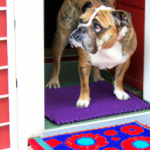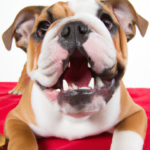Are you struggling with potty training your stubborn Bulldog? Look no further, as this article provides effective strategies tailored specifically for this challenging breed. Recognizing the unique characteristics and needs of English Bulldogs is essential in creating a successful training regimen. From understanding their individual diet and exercise routines to addressing their behavioral patterns, every aspect plays a significant role in achieving positive training outcomes. By implementing methods like crate training, reward-based learning, and seeking professional guidance if necessary, you can overcome common challenges and provide innovative, Bulldog-friendly alternatives. With a balanced approach of patience, consistency, and positive reinforcement, you’ll be well on your way to potty training success.
Understanding English Bulldogs
English Bulldogs are a unique breed with distinct characteristics that set them apart from other dogs. To effectively potty train an English Bulldog, it is essential to understand their specific needs and behaviors. English Bulldogs are known for their gentle and affectionate nature, but they can also be stubborn at times. This stubbornness can pose challenges during the potty training process, but with the right approach and understanding, it is possible to achieve success.
Characteristics of English Bulldogs
English Bulldogs have a distinctive appearance, with their wrinkled faces, stocky build, and short, sturdy legs. They have a low activity level, preferring leisurely walks and napping over high-energy exercise. This low energy level should be taken into consideration when structuring their potty training routine. They are also prone to certain health issues, such as respiratory problems and joint disorders, which can affect their ability to hold their bladder for extended periods. Understanding these characteristics will help in tailoring the potty training approach.
Unique needs of English Bulldogs
Due to their physical attributes and potential health issues, English Bulldogs have unique needs when it comes to potty training. Their bladder capacity may be limited compared to other breeds, making frequent potty breaks necessary. Additionally, their specific nutritional requirements, such as a balanced diet and proper hydration, can impact their bladder control and overall health. Taking these needs into account is crucial to ensure a successful potty training experience.
Importance of Potty Training for Bulldogs
Potty training is an essential aspect of owning any dog, and English Bulldogs are no exception. There are several reasons why potty training is important for Bulldogs, including maintaining cleanliness and preventing health issues.
Maintaining cleanliness
A well-trained English Bulldog will understand the appropriate place to relieve themselves, which helps maintain a clean and hygienic living environment for both the dog and their human family. Without proper potty training, Bulldogs may have accidents inside the house, leading to unpleasant odors and the need for constant clean-up.
Preventing health issues
Regular and consistent potty training can help prevent health issues in Bulldogs. Holding urine for extended periods can increase the risk of urinary tract infections and bladder problems. Proper potty training ensures that Bulldogs can relieve themselves regularly, reducing the chances of such health issues occurring.
Considerations for Potty Training Bulldogs
When potty training Bulldogs, several considerations need to be taken into account to ensure success. Two important factors to consider are the bladder capacity of Bulldogs and their specific nutritional requirements.
Bladder capacity of Bulldogs
Due to their physical characteristics and potential health issues, Bulldogs may have a limited bladder capacity. This means that they may need to go outside more frequently compared to other breeds. Understanding and accommodating their reduced bladder capacity is crucial to avoid accidents and maintain a consistent potty training routine.
Specific nutritional requirements
The diet of an English Bulldog can impact their potty training success. Providing a balanced and appropriate diet, including high-quality dog food and sufficient hydration, can support their overall health, including bladder control. Working with a veterinarian to determine the best nutritional plan for your Bulldog is recommended.
Training Methods for Bulldogs
There are various training methods that can be effective when potty training Bulldogs. It is important to choose methods that are suitable for their individual needs and behaviors.
Crate training
Crate training is a popular method for potty training Bulldogs. By using a crate, Bulldogs learn to associate the crate with their safe and comfortable den. This instinctual desire to keep their den clean can be leveraged during potty training. Bulldogs are generally clean animals, and they will naturally try to avoid soiling their crate, making it easier to teach them to hold their bladder until they are taken outside.
Reward-based learning
Reward-based learning involves rewarding Bulldogs with treats, praise, or affection when they exhibit desired behaviors, such as going potty outside. This positive reinforcement encourages Bulldogs to repeat the behavior, making it an effective potty training technique. Consistency and timing are key when using reward-based learning, ensuring that the reward is given immediately after the desired behavior is exhibited.
Professional guidance
If you are having difficulty potty training your Bulldog, seeking professional guidance can be beneficial. Professional dog trainers have experience working with different breeds, including Bulldogs, and can provide personalized advice and training techniques based on your dog’s specific needs. They can help you navigate through any challenges you may be facing and provide guidance on how to overcome them effectively.
Common Challenges in Potty Training Bulldogs
While potty training Bulldogs, there are common challenges that owners may encounter. Being aware of these challenges and knowing how to address them can help ensure a successful training process.
Regression
Bulldogs, like any other breed, can experience regression during the potty training process. Regression refers to a temporary setback where a previously trained dog starts having accidents again. This can happen due to various reasons, such as changes in routine, stress, or medical issues. It is important to identify the underlying cause of the regression and address it promptly to get back on track with potty training.
Indoor marking
Indoor marking is another challenge that Bulldog owners may face during potty training. Bulldogs, especially males, may have a tendency to mark their territory indoors. This behavior is instinctual and can be influenced by factors such as hormonal changes, anxiety, or a lack of proper potty training. Consistency, patience, and reinforcement of appropriate potty behavior can help curb indoor marking tendencies.
Solutions to Training Mistakes
Mistakes can happen during the potty training process, but it’s important to identify and correct them to maintain progress. Additionally, providing innovative training alternatives can assist in overcoming obstacles.
Identifying and correcting mistakes
When mistakes occur during potty training, it is crucial to identify the cause and address it promptly. This may involve evaluating the training routine, identifying any inconsistencies, or adjusting aspects of the dog’s diet or exercise routine that may be contributing to the issue. Consistency and clear communication with the dog are key to correcting and preventing future mistakes.
Providing innovative training alternatives
Innovative training alternatives can help address specific challenges or unique situations that may arise during potty training. For example, using indoor dog potty systems or artificial grass patches can provide a designated area for Bulldogs to relieve themselves indoors, which can be beneficial during extreme weather conditions or for households without easy access to outdoor spaces. These alternatives can help ensure a consistent and successful potty training experience.
Maintaining a Balanced Approach
To achieve potty training success with your Bulldog, it is essential to maintain a balanced approach that incorporates patience, consistency, and positive reinforcement.
Patience and consistency
Patience is key when potty training Bulldogs. It may take time for them to fully understand and consistently exhibit the desired potty behavior. Consistency in routine, commands, and reinforcement methods helps Bulldogs associate the appropriate behavior with positive outcomes, encouraging them to repeat it.
Positive reinforcement
Positive reinforcement plays a vital role in potty training Bulldogs. Celebrating and rewarding their successful potty behaviors, whether through treats, praise, or playtime, creates a positive association with going outside to relieve themselves. This positive reinforcement builds their confidence and reinforces the desired potty training behaviors.
Managing Regression in Potty Training
Regression may occur during the potty training process, but there are strategies to manage and overcome it effectively.
Identifying potential triggers
Identifying potential triggers for regression is essential in managing it. Changes in routine, stress, or medical issues can contribute to regression. By identifying and addressing these triggers, you can help your Bulldog get back on track with their potty training progress.
Implementing corrective measures
Once potential triggers for regression have been identified, implementing corrective measures is important. This may involve re-establishing a consistent routine, providing additional training sessions, or seeking the assistance of a professional dog trainer. By taking proactive steps to address regression, you can help your Bulldog regain their previous potty training success.
Dealing with Indoor Marking
Indoor marking can be a challenge during potty training, but understanding the underlying cause and establishing a consistent routine can help overcome it.
Understanding the underlying cause
Indoor marking is often driven by instinctual behaviors, such as marking territory or responding to hormonal changes. Understanding the underlying cause of indoor marking in your Bulldog is crucial in addressing and curbing this behavior. It may involve providing more opportunities for outdoor potty breaks, neutering or spaying your Bulldog, or using deterrents to discourage marking in inappropriate locations.
Establishing a consistent routine
Establishing a consistent routine is key to managing indoor marking. By providing regular and frequent opportunities for your Bulldog to go outside and reinforcing appropriate potty behaviors, you can help deter indoor marking tendencies. Consistency in training, reinforcement, and communication will help your Bulldog understand where and when it is appropriate to relieve themselves.
Conclusion
Potty training a stubborn Bulldog requires a comprehensive understanding of the breed’s characteristics, unique needs, and effective training methods. By considering their physical attributes, nutritional requirements, and using appropriate training techniques, you can overcome common potty training challenges. Maintaining a balanced approach with patience, consistency, and positive reinforcement encourages desired behaviors and prevents regression. With proper management of regression and indoor marking, you can successfully potty train your Bulldog, creating a clean and harmonious living environment for both you and your beloved pet.




